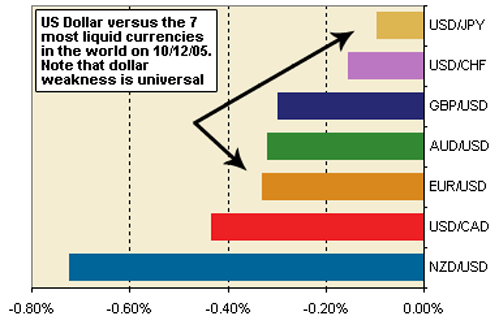Make The Currency Cross Your Boss
Thursday, July 1, 2010
In the stock market, a trader has the opportunity to choose from more than 5,000 companies - hundreds of which will rally in the most vicious of bear markets and thousands of which will crash during the strongest of bull runs. But in the currency market, such divergent possibilities do not seem to exist. In this article, we'll look at how forex traders can use currency crosses to make a wide variety of trades that are unaffected by the day-to-day fluctuations of the greenback.
All Currency Bets Are the Same
When dealing in the major currency pairs, most traders are presented with only one choice: dollar bull or dollar bear? Regardless of whether a trader is long the GBP/USD (British pound-U.S. dollar) or the EUR/USD (euro-dollar), or short the USD/CHF (dollar-Swiss franc) or USD/JPY (dollar-Japanese yen), the unifying theme in all of these positions is that the trader is bearish on the greenback. Therefore, the question of which of the four trades should be taken is immaterial, since all of them will likely be profitable if the dollar is weak and all will lose money if the dollar is strong.
Granted, this may sound like a gross oversimplification of the forex market. We'll be the first to acknowledge that some currencies can and do challenge this paradigm - the Canadian dollar is one good recent example of such a dynamic. Buoyed by skyrocketing oil prices, the loonie has turned into a petrocurrency as
To better understand how this works, let's take a look at the two charts below. Figure 1 looks at the performance of the seven most liquid currency pairs in forex, composed of the four majors:
- EUR/USD
- USD/JPY
- GBP/USD
- USD/CHF
- USD/CAD
- AUD/USD
- NZD/USD
Figure 1 looks at activity on a single trading day - October 12, 2005. To normalize the data, we converted every pair so that its performance could be analyzed accurately. Typically, if the dollar were weak, the EUR/USD would rise and the USD/CHF would decline; however, in Figure 1 we have made the adjustment so that the returns are consistent vis a vis the dollar.

Figure 1: In forex, some currency pairs are quoted in terms of the U.S. dollar (e.g. EUR/USD), while others are not (e.g. USD/CHF). By inverting the pairs that are not expressed in terms of the dollar, we can compare the strength/weakness of each pair relative to the dollar. Source: DailyFX.com
Figure 2 looks at activity on the same trading day - October 12, 2005 - for the Dow Jones Industrial Average.
| Figure 2: In FX, most traders (those trading the seven most liquid currency pairs) are presented with only one choice - dollar bull or dollar bear - but the stock market is less straightforward. As this chart shows, even when an index like the DJIA is down overall, many of its stocks can be up, making it harder to take a purely bearish or bullish outlook. |
| Source: DowJones.com |
Both of these charts clearly illustrate that while the stock market is truly a market of stocks, the currency market is really a market of dollars and anti-dollars. The central reason why this is so is that the dollar serves as the reserve currency for the world's central banks. Therefore, when speculators are bullish on the dollar, capital will flow from all the major currencies into the greenback and vice versa when the sentiment reverses.
Crosses Offer More Possibilities
If you look closely at Figure 1, however, you'll notice that the capital flows are far from uniform. Some currencies appreciate substantially against the dollar, while others gain barely a few basis points. This difference in performance against the greenback creates profit opportunities for market players who choose to trade in currency crosses. Crosses are simply a measure of the relative strength of an individual currency against the dollar. Crosses are distinguished by the fact that they do not include the dollar as either the numerator or the denominator of the pair. As such, they offer traders a tremendous opportunity to make far more nuanced bets in the currency market than the simple pro- or anti-dollar trade.
What makes crosses especially interesting to currency traders is the fact that they can provide much cleaner trend or range signals which will be unaffected by the day-to-day oscillations of the greenback.
To better understand how crosses work, let's examine the following two charts, which look at data over the same period of time (from July 1, 2005 to October 14, 2005). While the most liquid financial instrument in the world - the EUR/USD - has done nothing but range aimlessly during the period in question, frustrating both bulls and bears (see Fig. 3), the CAD/JPY has displayed one of the purest trends in recent memory, gaining almost 1,000 points without any material retracement (see Fig. 4).
0 comments:
Post a Comment